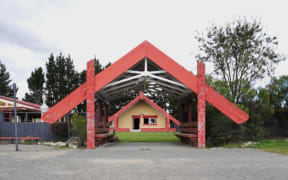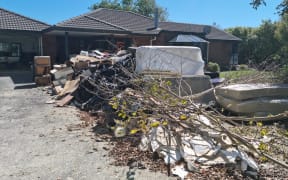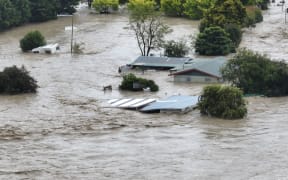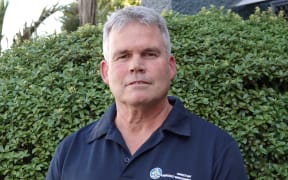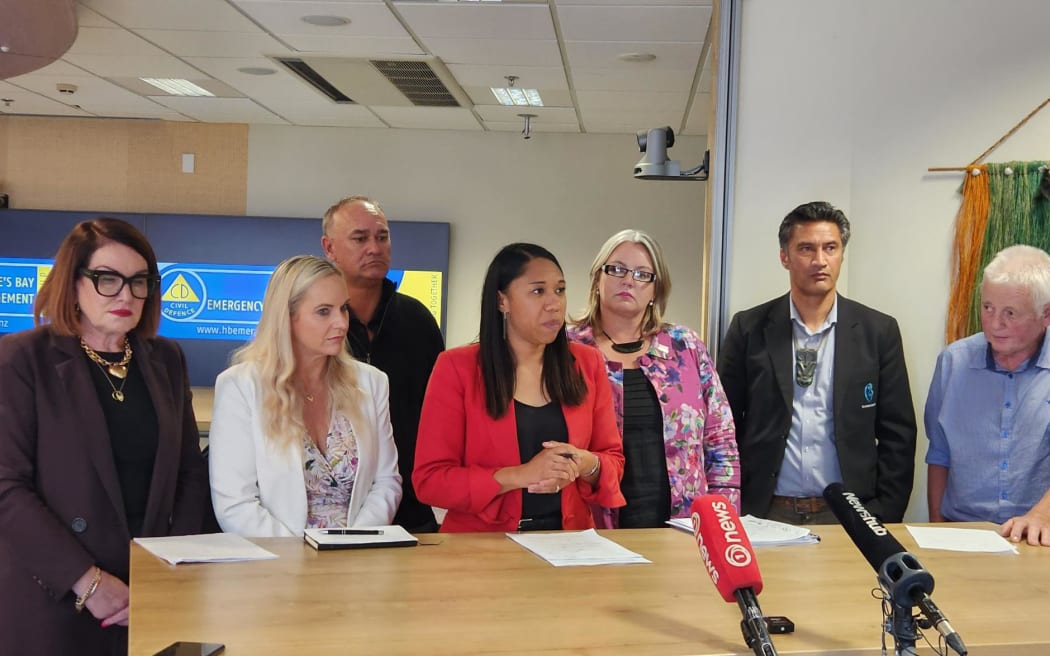
Mayors of the districts heavily affected by Cyclone Gabrielle fronted a media conference at the release of a report in to the Civil Defence response to the disaster. Photo: RNZ / Anusha Bradley
Eight things that stood out in the review of the Civil Defence response to Cyclone Gabrielle.
On Monday, an independent review of the Hawke's Bay Civil Defence Emergency Management (CDEM) Group's response to Cyclone Gabrielle was published.
The disaster on 14 February last year killed eight people, destroyed hundreds of homes and businesses and left thousands displaced.
The 117-page review by former Police Commissioner Mike Bush was scathing.
A few findings stand out. Some are a bit weird - even funny. Some, alarming.
'Epic feats' to sign a piece of paper
Bush's report paints a farcical picture of the effort required just to declare a state of emergency when the cyclone arrived.
While there was debate as early as Sunday 12 February about whether an emergency should be declared, a decision was not made to declare one until the cyclone started to bear down on the North Island late on Monday evening.
A formal declaration requires a mayor to put pen to physical paper, so staff had to go out into the storm.
"There is something both farcical and dangerous in the current requirement for mayors to physically sign a declaration of emergency by hand on a piece of paper," the report states.
"Epic feats, for example, were required of CDEM staff to travel, in the height of the storm, to a Mayor's flooded home to deliver the paper for signing. Similar stories applied with regard to the Chair of the CDEM Group and other mayors.
"In spite of the heroic efforts of staff, this cost time and seems an oddity in the 21st century context."
Bush suggests it's worth considering if emergency declarations can be given verbally or online in future.
An excess of 'adrenalinised desk jockeys'
When the declaration of a state of local emergency came, the Group Emergency Coordination Centre (GECC) was activated to lead the response to the cyclone for the entire region.
The response was "often chaotic".
"There was a consensual approach to decision making, as opposed to decisions made on the basis of intelligence and with clear command lines," Bush finds.
"GECC teams relied on adrenalin and heroics, as opposed to training, operational experience and muscle memory. They functioned well enough in short bursts but momentum was hard to sustain over a long period."
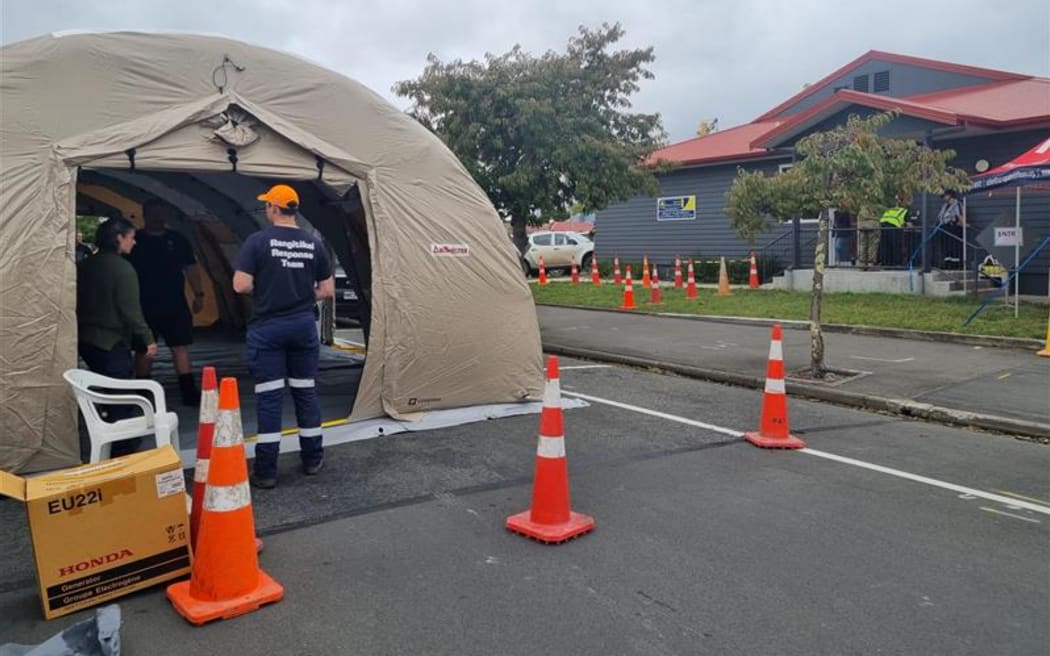
A temporary tent was erected to fit more people at the headquarters of the Hasting Civil Defence Emergency Management effort. Photo: Tess Brunton/RNZ
There was no clear line of command, resulting in "too many cooks in the kitchen".
"Some respondents told us that, in the words of one, 'far too many adrenalinised desk jockeys cluttered the initial response effort with the result that some of the key professionals found engagement with the GECC slow and frustrating. People in the GECC were well intentioned but operationally inexperienced'."
Staff 'retreated to a cupboard' in an overcrowded office
The chaos made it hard for established agencies - described 'all of government (AoG) networks - to contribute.
"The Ministry of Social Development (MSD) Regional Commissioner is the lead for government agencies in the region and these AoG resources were, initially, poorly connected to the local EOCs [emergency operation centres] and GECC.
"Relationships held by these agencies could have eased a number of challenges the Group was facing. MSD has six service centres across the region and strong relationships into local marae. Waka Kotahi held some of the critical data on State Highway roads and bridges. The Ministry of Education had networks amongst school principals. Te Whatu Ora needed to bring the public health dimension to the event earlier than it was able to. Te Puni Kokiri had deep relationships with key iwi leaders, and so on.
"These agencies found it challenging to have their voices heard in the GECC and to understand what was going on. Initially at least, they tended to meet separately to resolve response and recovery issues. At one point, transport staff told us they retreated to a cupboard in the overcrowded Hastings CDEM facility."
The operating model of the GECC should be reconsidered, Bush says, and the regional 'All of Government' lead could be added into the CDEM Group.
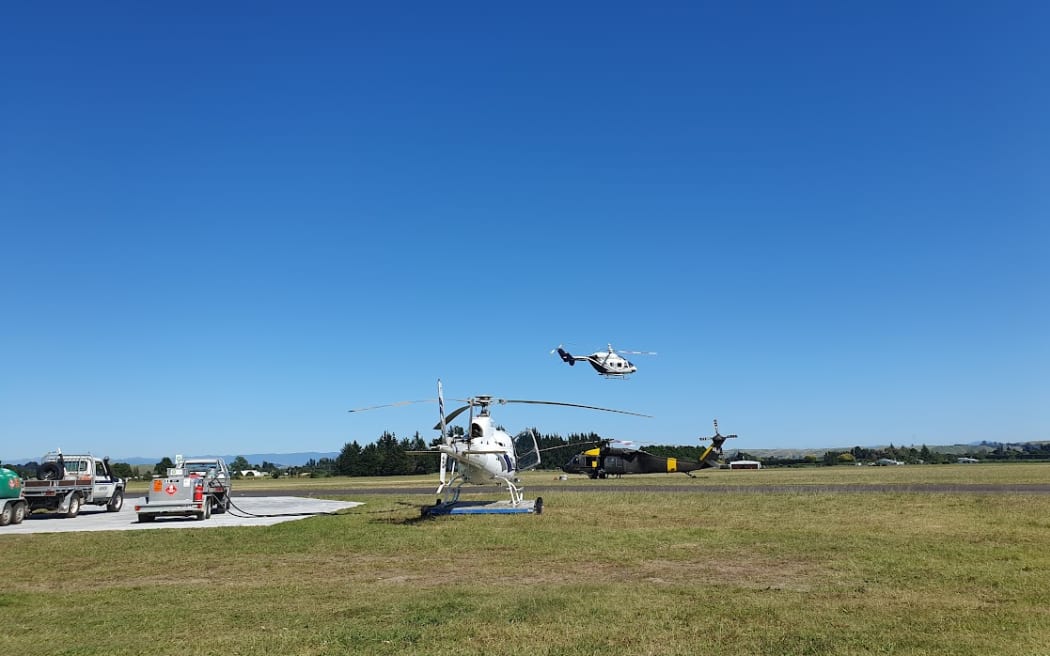
Hastings aerodrome Photo: RNZ/Sally Round
Overloaded aircraft, unreliable fuel supply at 'chaotic' aerodrome
Hastings Aerodrome was the designated emergency airfield in the response, but it hadn't been used as such since the 1930s and contingency plans were "underdeveloped".
All flight authorisations, including the Defence Force's helicopters, private helicopters and various small aircrafts to transport hospital patients and other community members were initially managed by FENZ.
"At one point in the early days of response GECC asked FENZ to stop tasking and took over, with what some respondents described as chaotic results. A short time later, FENZ control was restored.
"Expert responders also expressed concern at the frequent overloading of aircraft arising from the lack of an expert in a loadmaster role."
There were other concerns too. The aerodrome's water supply and wastewater struggled to accommodate the hundreds of responders and evacuees on site; the access road to the aerodrome had to be upgraded for the many heavy vehicles using it; and the supply of jet fuel had not been preplanned and was "unreliable."
The aerodrome had to stop its normal business so took a financial hit, as well as incurring costs such as upgrading the road and improving water supply.
"At the time of writing, these expenses remained outstanding and there is no obvious mechanism to recover these costs from central/local government."
Bush recommends a proper plan be developed, including cost recovery arrangements, for the aerodrome, and the creation of a special helicopter manager role to coordinate airspace when it's in use as an emergency airfield.

Mike Bush Photo: RNZ / Samuel Rillstone
Social media hot, mainstream media not
Residents told Bush they felt communications were sparse, too generic and overly concentrated into social media channels, which many could not access because they did not have power, mobile coverage, or internet.
The CDEM Group "lacked a fulsome and pretested communications plan" for a major disaster, meaning it had to be developed on the fly, while there was no clear criteria for when emergency mobile alerts should be sent.
Not all communications staff had training or an understanding of the media's role in lifeline communications channels so the use of national media, such as public radio, was "arguably underutilised."
But there was also an unwillingness from some communications staff to engage the media.
"We have formed the view that some staff in the communications space carried their 'defensive' postures toward external media into the emergency space, where these have no place and media become a critical communications partner and ally."
Bush recommends a review of the depth and capability of the public information workforce to ensure they all have training. NEMA should develop a pre-planned communications plan for emergency use, along with clear criteria for the use of emergency mobile alerts.
Mana whenua 'ignored'
Iwi were well prepared, organised and had local contacts and knowledge but were largely ignored in the lead up to the disaster and in the early days after.
"There was considerable frustration in advance of the event about the weak connection with Taiwhenua service providers, in that they were not engaged by the CDEM group in preparing for the event.
"One Taiwhenua entity had staff with CIMS and Te Puni Kokiri training, was tracking weather and planning its 'worst case scenario' (which proved accurate) response. There was little coordination between their command structures and those of CDEM.
"Māori leaders and communities were also deeply frustrated that the GECC created geographic zones with hubs to service isolated communities throughout the region instead of using the established network of marae. This created confusion, was not clearly communicated to Māori wardens and iwi liaisons and left mana whenua feeling that their proven expertise in community service support was being ignored and disrespected."
The CDEM also failed to tap into indigenous knowledge about which areas would be worst affected. One said: "We know this whenua and how its waters behave. We know which Pa and marae are above the flood zone and we know how to contact and support our people. We know how to support traumatised people with manaakitanga. Why wasn't all that built into the system from the start?"
Bush recommends formalising iwi partnerships at all civil defence levels, including nationally with NEMA.
'Incidents within the incident'
The 'fly by wire' ethos of the response imposed a high toll on staff who suffered physical exhaustion and mental ill health. Many had little to no training in emergency management and some were thrust into roles without knowing what was expected.
Some trained staff in key positions were turned away from the GECC after testing positive for Covid.
"This increased the burden on remaining staff. In the event, the urgent need for specialist skills in the first hours of the response perhaps outweighed infection risk."
Staff rotated between different roles on a daily basis with poor handover resulting in repeated tasks, disrupted working relationships and loss of "corporate memory".
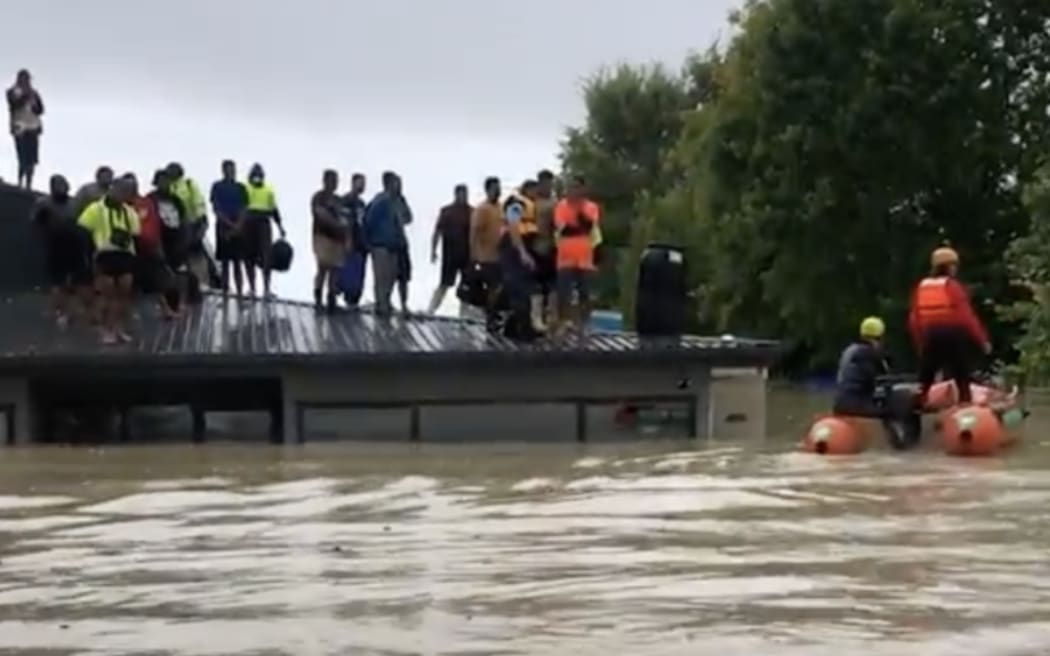
Extraordinary rescue efforts at the height of the crisis created by Cyclone Gabrielle Photo: SUPPLIED
Many of the systems and processes used were unsuitable for an event of this nature.
"This comment was also typical of several: 'The GECC was chaos. No organisation initially. No focus. No structure. People everywhere. No disaster SOPs. People working in silos making poor decisions'."
Poor workforce planning and rostering led to staff "burn out and fatigue".
"The lack of a plan to deal with 'incidents within the incident' and meet the needs of staff who were themselves impacted by the disaster did not help.
"The ongoing trauma still being experienced by some response staff and key officials was evident in our interviews. Many others have left their positions."
Bush recommends a full event debrief with all staff be undertaken, facilitated by a mental health professional.
'A bullet that needs to be bitten'
Bush accepts the recommendations in his report "come with a cost."
"For this reason it was common for respondents to say… 'But why are you bothering? No Government wants to bite the bullet of funding this properly'.
"But this bullet needs to be bitten, if only to ensure that insurance and reinsurance costs, both public and private, remain within acceptable bounds."
He urges the government and organisations involved in the response to make the necessary changes.
"Improving and embedding lessons learned is a significant challenge for all emergency management systems, regionally, nationally and internationally.
"It will be critical that both Hawke's Bay CDEM Group and the national CDEM system learn from the events of Cyclone Gabrielle. Doing so will require tenacity and focus by local and national leaders."

